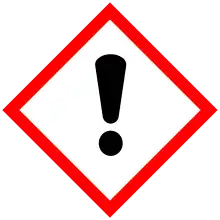Erbium(III) nitrate
Erbium(III) nitrate is an inorganic compound, a salt of erbium and nitric acid with the chemical formula Er(NO3)3.[1][2][3] The compound forms pink crystals, readily soluble in water, also forms crystalline hydrates.[4][5]
 | |
| Names | |
|---|---|
| Other names
Erbium trinitrate, Erbium nitrate | |
| Identifiers | |
| |
3D model (JSmol) |
|
| ChemSpider |
|
| EC Number |
|
PubChem CID |
|
CompTox Dashboard (EPA) |
|
| |
| |
| Properties | |
| Er(NO3)3 | |
| Molar mass | 353.274 |
| Appearance | Pink crystals |
| Melting point | 430 °C (806 °F; 703 K) |
| Soluble | |
| Hazards | |
| GHS labelling: | |
   | |
| Danger | |
| H272, H315, H318, H319, H335 | |
| P210, P220, P221, P261, P264, P271, P280, P302+P352, P304+P340, P305+P351+P338, P310, P312, P321, P332+P313, P337+P313, P362, P370+P378, P403+P233, P405, P501 | |
| Related compounds | |
Related compounds |
Terbium(III) nitrate |
Except where otherwise noted, data are given for materials in their standard state (at 25 °C [77 °F], 100 kPa).
Infobox references | |
Synthesis
Dissolving metallic erbium in nitric acid:
Dissolving erbium oxide or hydroxide in nitric acid:
Reaction of nitrogen dioxide with metallic erbium:
Physical properties
Erbium(III) nitrate forms pink hygroscopic crystals.
Forms crystalline hydrates of the composition .
Both erbium(III) nitrate and its crystalline hydrate decompose on heating.
Chemical properties
The hydrated erbium nitrate thermally decomposed to form ErONO3 and then to erbium oxide.
Applications
It is used to obtain metallic erbium and is also used as a chemical reagent.
References
- Steglich, Patrick (21 October 2020). Electromagnetic Propagation and Waveguides in Photonics and Microwave Engineering. BoD – Books on Demand. p. 42. ISBN 978-1-83968-188-2. Retrieved 19 August 2021.
- Милешко, Леонид; Гапоненко, Николай (21 February 2020). Основы процессов получения легированных оксидных пленок методами золь-гель технологии и анодного окисления (in Russian). Litres. p. 42. ISBN 978-5-04-234580-7.
- Лидин, Ростислав; Молочко, Вадим; Андреева, Лариса (2 February 2019). Константы неорганических веществ. Справочник (in Russian). Litres. p. 37. ISBN 978-5-04-077039-7. Retrieved 19 August 2021.
- Registry of Toxic Effects of Chemical Substances. National Institute for Occupational Safety and Health. 1987. p. 2186. Retrieved 19 August 2021.
- Macintyre, Jane E. (23 July 1992). Dictionary of Inorganic Compounds. CRC Press. p. 3120. ISBN 978-0-412-30120-9. Retrieved 19 August 2021.
- Sr, Richard J. Lewis (13 June 2008). Hazardous Chemicals Desk Reference. John Wiley & Sons. p. 591. ISBN 978-0-470-18024-2. Retrieved 19 August 2021.
This article is issued from Wikipedia. The text is licensed under Creative Commons - Attribution - Sharealike. Additional terms may apply for the media files.